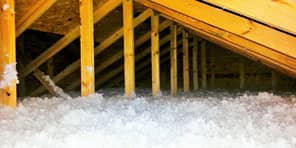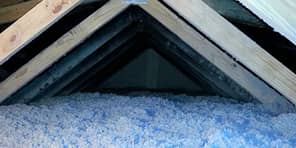St Louis - St Charles Insulation Company.


Which insulation is best for my attic?
If you know you need insulation, but you just aren’t sure of what type, it’s time to do a little homework on the subject. When you hire professional insulation contractors in St. Louis, you will be given expert advice on which type is best for your unique situation. From spray foam and fiberglass batts to cellulose and loose-fill fiberglass, there are many choices out there. Let’s go over the pros and cons of each.
Blown In Insulation
Blown in insulation, made of cellulose or fiberglass, is quickly becoming the insulation of choice for both professionals and DIY homeowners. Also known as loose fill insulation, this type is comprised of loose particles that can be blown into an attic or wall. Because it fills all the air pockets, heating and cooling can’t escape. This is a great, all-over option that can help you control the comfort level in your home while slashing energy bills.
Pros of Blown In Insulation
- Fills gaps efficiently
- You can layer it for added protection.
- It flows down around wall studs.
- It’s flame resistant.
- It’s non-toxic.
Cons of Blown In Insulation
- Can get messy
- Requires professional installation.
- Can cause sagging of the ceiling.
- Can lead to fungal growth.
- Creates problems when wet.
Spray foam Insulation
With a high R-value and air sealing quality, spray foam insulation is available in open cell and closed cell foam. Because of its vapor-retarding qualities, this results in a pretty good savings on utility bills each year.
Pros of Spray Foam Insulation
- Has a high R-value.
- Is a very good air barrier because it hardens when dried.
- It fills tight, hard-to-reach spots.
- It can be applied to attic ceilings.
- Features zero heat transfer through convection.
Cons of Spray Foam Insulation
- They’re more expensive than other types.
- They require professional application.
- Can pose health risks due to chemicals in the spray foam.
- Reduces the need for other home weatherizing tasks, like caulking.
Fiberglass Batts & Blanket Insulation
This is the most common insulation, available in rolls that are pre-sized to fit between joists and studs. Blankets and batts fiberglass insulation are both readily available and affordable, great for both new construction and gut-renovation projects. Batts usually come in 16 or 24 inches wide to fit between studs and four or eight feet tall to fit the height. This is most common in new construction and remodeling projects, as they fit snugly into the space between studs and joints.
Pros of Fiberglass Batts and Blankets Insulation
- Does not contain harmful chemicals.
- It’s fire-resistant.
- They do well against burst pipe water damage.
- Are the best option for DIY jobs.
Cons of Fiberglass Batts and Blankets Insulation
- They don’t conform to odd or tight spaces.
- They can leave gaps.
- The material will compress with time.
- Need to wear personal protection gear when working with fiberglass.
- Can irritate your lungs and leave you feeling itchy.
Many Insulation Options To Choose From
There are many types of insulation out there. The one for you will depend on many things, like your budget, home style and needs.
Contact Addict Insulation In Missouri
For more advice as to which type of insulation is best for your home, get in touch with our ST Louis insulation contractors located in St. Charles. Just call us at 636-233-7314 or fill out our online form.
Energy Saving BlogMissouri Insulation Company
Popular Articles
- FAQs About Insulation in Missouri
- What Areas Should You Insulate Before Winter?
- The Greatest Risks to Your Home Caused by Poor Insulation
- Why Your Utility Bills Are So High and What You Can Do About It
- Can You Put New Insulation Over Old?
- Here Are 3 Ways Your Attic Could be Contaminated
- How Home Insulation Works in the Summer
- Tips and Tricks For Summer Insulation
- How to Fix Indoor Condensation
- Choosing the Right Spray Foam Contractor
- Why You Need Power Washing This Spring
- Don't Let Air Escape Your Home
- Tips For Saving on Your Energy Bills This Summer
- Should I Install a Radiant Barrier in My Home?
- Are You Wondering if Your Attic Has Enough Insulation?
- Do I Have to Replace Wet Insulation?
- Insulating Your Sunroom
- Should You Insulate Your Outdoor Spaces?
- All About Removing Insulation
- What to Know About Insulating a Crawl Space
- How to Spot Mold in Your Wall Insulation
- How to Prevent Moisture in Your Warehouse With Spray Foam Insulation
- What Factors Cause Heat Gain?
- The Problems That Come With Improper Insulation
- Insulation FAQs
- Why Should You Check the Insulation When Buying a Home?
- Why Seal and Insulate Your Home?
- Home Insulation: Safety and Health
- Should You Remove Old Insulation During Replacement?
- Can I Stay Inside My Home During Spray Foam Insulation Installation?
- Pros and Cons of Converting an Attic
- Pros and Cons of Converting an Attic
- When’s the Best Time to Insulate Your House?
- The Difference Between Blown Insulation and Spray Foam Insulation
- Is Your Garage Loft Too Hot or Too Cold? Heed These Tips
- 6 Health Benefits of Having a Quiet Home
- Insulation Prep is Critical For Installation
- The Dangers of Removing Insulation on Your Own
- What’s the Most Eco-Friendly Insulation?
- 7 Benefits of Spray Foam Insulation
- What is the Proper Insulation For Vaulted Ceilings?
- Signs Your Crawlspace Insulation Should be Replaced
- Why You Should Insulate Your Basement Walls
- Most Effective Ways to Soundproof Your Home Office
- How to Insulate an Old House
- 4 Tips to Make Your Attic More Energy Efficient
- Attic Insulation Problems: 5 Things to Look Out For
- What Causes Condensation on Interior Walls?
- How Deep Should Your Insulation Be?
- What to Consider When Choosing an Insulation Company
- Can You Add New Insulation Layers Over Old Ones?
- When Should You Remove Insulation?
- 7 Tips For an Energy Efficient Summer
- Creating a Healthy, Comfortable and Productive Workspace When Working From Home
- Why is Roof Ventilation Just as Important as Insulation?
- Why Spring is a Good Time to Insulate Your Attic
- 5 Signs of Damaged or Insufficient Insulation
- Is the Insulation in Your Walls Making You Sick?
- Under-Insulated Areas You May Be Overlooking
- The History Of Insulation.
- Pros and Cons of Attic Insulation
- Do You Need Insulation When Finishing a Basement?
- What is Drill and Fill Insulation?
- Which Insulation is Best for Garage Walls?
- How Air is Escaping Your Home and How to Prevent It
- 10 Things You Must Absolutely Insulate Before Winter
- 5 Reasons To Not DIY Insulation
- 5 Signs of an Under-Insulated Home
- 5 Benefits of Blown Insulation
- Cellulose vs. Fiberglass Insulation
- When is Insulation Removal Necessary?
- Tips to Keep Your Home Cool This Summer
- What is the Best Insulation for a Flat Roof?
- 5 Benefits of Power Washing
- Q & A About Insulation
- Reviews
- Energy Saving Blog






